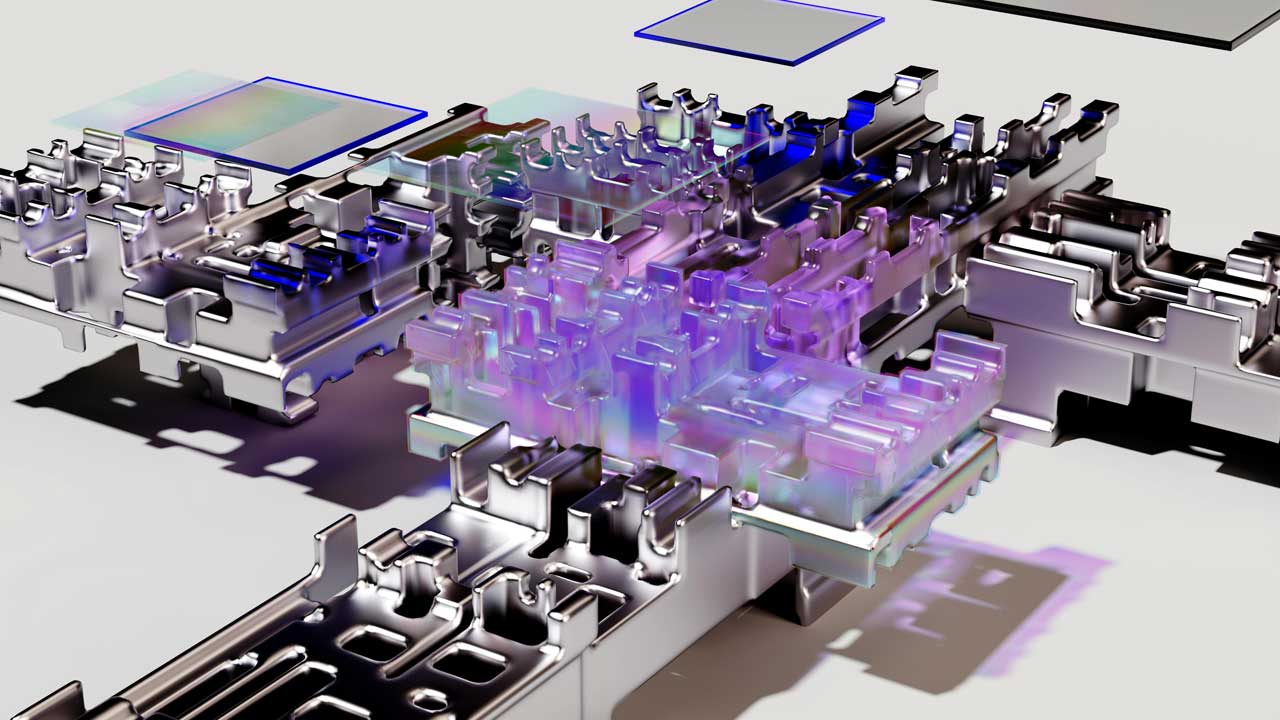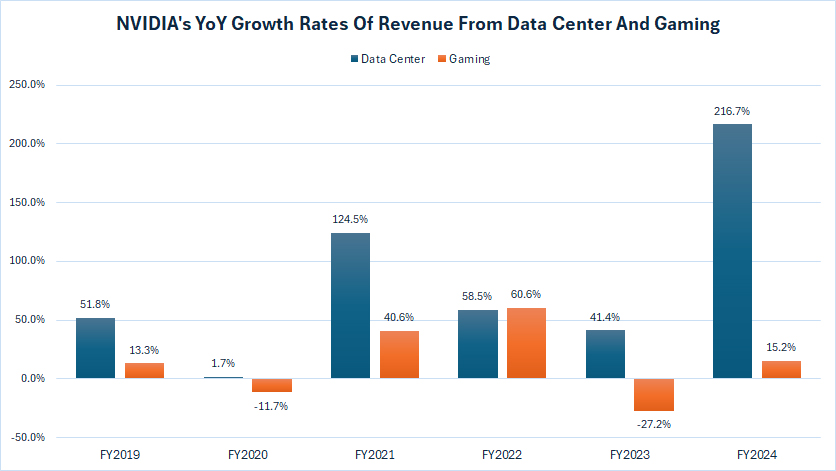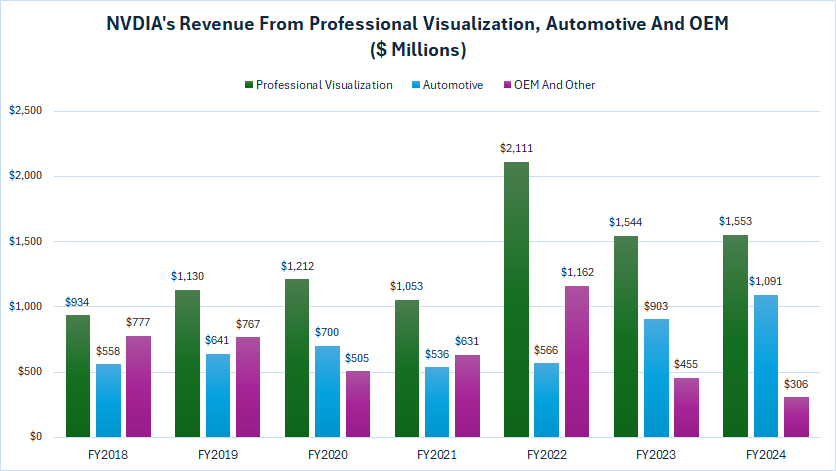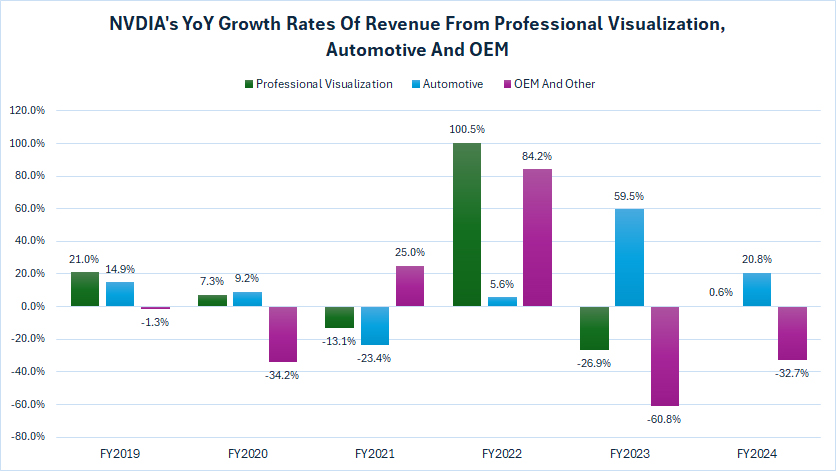
Artificial Intelligence. Pexels Images.
Nvidia Corporation (NASDAQ: NVDA) is a multinational technology company incorporated in Delaware and based in Santa Clara, California. It was founded in 1993 by Jensen Huang, Chris Malachowsky, and Curtis Priem. Nvidia is best known for its Graphics Processing Unit (GPU) products.
Originally focused on the gaming market, its GPUs are now used in systems for artificial intelligence (AI), deep learning, and autonomous vehicles, marking Nvidia as a significant player in various tech industries beyond gaming.
Nvidia’s technology is instrumental in driving advancements in scientific research, healthcare, and environmental studies through high-performance computing and AI.
This article delves into Nvidia’s revenue by market or product segment. For your information, Nvidia focuses on four large markets where its expertise is critical: Data Center, Gaming, Professional Visualization, and Automotive.
Let’s get started.
Please use the table of contents to navigate this page.
Table Of Contents
Definitions And Overview
O2. List Of Nvidia’s Products For The Data Center Market
O3. List Of Nvidia’s Products For The Gaming Market
O4. List Of Nvidia’s Products For The Professional Visualization Market
O5. List Of Nvidia’s Products For The Automotive Market
Data Center And Gaming
A1. Revenue From Data Center And Gaming
A2. Percentage Of Revenue From Data Center And Gaming
A3. Growth Rates Of Revenue From Data Center And Gaming
Professional Visualization, Automotive, And OEM
B1. Revenue From Professional Visualization, Automotive, And OEM
B2. Percentage of Revenue From Professional Visualization, Automotive, And OEM
B3. Growth Rates Of Revenue From Professional Visualization, Automotive, And OEM
Summary And Reference
S1. Summary
S2. References and Credits
S3. Disclosure
Definitions
To help readers understand the content better, the following terms and glossaries have been provided.
Data Center: Nvidia’s Data Center segment is a crucial part of the company’s business, focusing on products and services specifically designed for data center applications.
This segment includes high-performance GPUs and networking solutions essential for accelerating computing in data centers. These products are used in a variety of applications, including cloud computing, big data analytics, artificial intelligence (AI), machine learning, and scientific computing.
Nvidia’s data center solutions are designed to significantly improve processing speed, efficiency, and power consumption, making them ideal for supporting the infrastructure of modern, data-intensive tasks and services.
Gaming: Nvidia’s Gaming segment primarily focuses on designing, developing, and marketing graphics processing units (GPUs) for gaming and PCs.
This segment includes GeForce GPUs for PCs, laptops, and cloud gaming services, designed to deliver high-performance gaming experiences with superior image quality and immersive virtual reality capabilities. It also encompasses gaming consoles, such as the Nintendo Switch, which uses Nvidia technology.
The Gaming segment is central to Nvidia’s business, leveraging the company’s expertise in parallel processing to drive innovations in gaming graphics and artificial intelligence features, enhancing the overall gaming experience for users.
Professional Visualization: Nvidia’s Professional Visualization segment focuses on developing and selling hardware and software solutions that enable professional users to create, visualize, and manage 2D and 3D content.
This includes graphics processing units (GPUs) and related platforms, such as Quadro, NVIDIA RTX, and NVIDIA Omniverse, aimed at professionals in architecture, engineering, medical imaging, digital content creation, and more.
These solutions help render complex designs, simulations, and visualization tasks more efficiently, enhancing productivity and enabling more immersive and detailed visual experiences.
Automotive: Nvidia’s Automotive segment focuses on developing and integrating artificial intelligence (AI) and graphics technologies for the automotive industry. This includes autonomous driving systems, in-vehicle infotainment solutions, and cockpit visualization systems.
Utilizing Nvidia’s expertise in GPU (Graphics Processing Unit) technology, deep learning, and parallel computing, the Automotive segment aims to revolutionize how vehicles are driven, operated, and experienced. Nvidia’s platforms, like DRIVE AGX, enable cars to perceive the world around them, make split-second decisions, and navigate safely, paving the way toward fully autonomous vehicles.
Additionally, Nvidia’s software and services in this segment support the development and deployment of these advanced automotive solutions, ensuring that vehicles become safer and more enjoyable for passengers through advanced entertainment and interactive features.
OEM: Nvidia’s OEM segment refers to the company’s part that deals with original equipment manufacturers.
This segment is responsible for developing and selling products and technologies to OEMs that integrate Nvidia’s graphics processing units (GPUs), system-on-a-chip units (SoCs), and other technologies into their products. These products can range from personal computers, laptops, and servers to gaming consoles and automotive infotainment systems.
The OEM segment allows Nvidia to leverage its advancements in GPU technology across a broad range of consumer and professional electronics, providing the computational power or graphics capabilities these products require.
List Of Nvidia’s Products For The Data Center Market
Nvidia offers a wide range of products tailored for the data center market, focusing on high-performance computing, AI, and deep learning applications. Some of their key product lines include:
1. **NVIDIA A100 Tensor Core GPU**: Designed for a wide range of compute-intensive workloads, including AI, deep learning, data analytics, and high-performance computing (HPC).
2. **NVIDIA H100 Tensor Core GPU**: The latest in their lineup, geared towards AI and HPC, it’s built on the Hopper architecture and offers significant improvements in performance for AI workloads and large-scale HPC applications.
3. **NVIDIA DGX Systems**: These are integrated hardware and software systems designed for deep learning and AI research. They come equipped with powerful NVIDIA GPUs and are optimized for accelerating deep learning algorithms.
4. **NVIDIA HGX**: This is a line of AI supercomputing platforms designed for cloud data centers. HGX combines the power of NVIDIA GPUs with high-speed interconnects to deliver unparalleled compute efficiency.
5. **NVIDIA Networking (including Mellanox Technologies products)**: NVIDIA’s networking solutions, which came into the fold after the acquisition of Mellanox Technologies, include high-performance InfiniBand and Ethernet networking products. These are crucial for scaling computing performance in data centers.
6. **NVIDIA BlueField Data Processing Units (DPUs)**: These are powerful processors designed to offload, accelerate, and isolate data center workloads. DPUs can handle networking, storage, and security tasks, thus freeing up CPU resources for computing tasks.
7. **NVIDIA AI Enterprise**: Although not a hardware product, NVIDIA AI Enterprise is a comprehensive software suite with support and tools for companies looking to implement AI in their data centers. It is optimized to run on NVIDIA-certified systems.
8. **NVIDIA CUDA-X AI**: This is a collection of libraries, tools, and technologies designed to significantly speed up the performance of deep learning and AI algorithms on NVIDIA GPUs.
These products demonstrate NVIDIA’s focus on accelerating computing across various domains within the data centre market, particularly in AI and HPC.
List Of Nvidia’s Products For The Gaming Market
Nvidia offers a wide range of products tailored for the gaming market. The offerings include but are not limited to:
1. **GeForce RTX Series Graphics Cards**: These are Nvidia’s flagship gaming GPUs, built on the Ampere architecture. They offer real-time ray tracing, AI-enhanced graphics, and high-performance memory for an incredible gaming experience. Models include the RTX 3090, RTX 3080, RTX 3070, and, more recently, the RTX 40 series cards like the RTX 4090 and RTX 4080, which significantly improve performance and efficiency.
2. **GeForce GTX Series Graphics Cards**: Designed for gamers and performance enthusiasts, the GTX series includes models like the GTX 1660 Ti, GTX 1660, and GTX 1650. These cards are known for solid performance in popular games at 1080p and 1440p resolutions.
3. **G-Sync Monitors**: Nvidia’s G-Sync technology is designed to eliminate screen tearing and minimize display stutter and input lag. G-Sync monitors come in a variety of resolutions, sizes, and refresh rates to suit different gaming needs.
4. **Nvidia Shield**: The Shield range includes devices like the Shield TV and Shield TV Pro, which are streaming media players with gaming capabilities. They support 4K HDR content, have built-in Google Assistant, and can stream games from a PC with a GeForce GPU or via cloud gaming services.
5. **GeForce NOW**: Nvidia’s cloud gaming service allows players to stream games from Nvidia’s servers directly to their computers, Shield TV, or mobile devices. GeForce NOW supports a wide range of popular games and is constantly updated with new titles.
6. **Nvidia Reflex**: This is a suite of technologies and features designed to minimize and measure system latency in competitive games, providing gamers with a more responsive and immersive gaming experience.
7. **Nvidia Studio**: While not exclusively for gaming, Nvidia Studio laptops and desktops are equipped with RTX GPUs that significantly benefit content creators in the gaming community, offering powerful performance for game development, video editing, and 3D rendering.
8. **DLSS (Deep Learning Super Sampling)**: This AI-driven technology in RTX series cards boosts frame rates while retaining beautiful, sharp game images, allowing higher settings and resolutions without compromising performance.
Nvidia’s product lineup is always evolving, with a strong emphasis on innovation to provide gamers with the best possible experience across a wide range of platforms and genres.
List Of Nvidia’s Products For The Professional Visualization Market
Nvidia sells a range of products under its Professional Visualization market segment, catering to professionals in design, visualization, and content creation. Here’s a list of some of the key offerings:
1. **Nvidia RTX GPUs**: These are high-end graphics cards designed for professional workstations. They are built to handle intensive tasks such as 3D rendering, video editing, and content creation, offering real-time ray tracing and AI-enhanced graphics.
2. **Nvidia Quadro GPUs**: Although Nvidia has been transitioning the Quadro brand into the broader RTX lineup, Quadro GPUs have historically been synonymous with professional visualization, delivering precise and reliable performance for professionals in AEC (Architecture, Engineering, Construction), media and entertainment, healthcare, and scientific visualization.
3. **Nvidia Omniverse**: This is a platform for 3D design collaboration and real-time photorealistic simulation. Omniverse allows professionals across various industries to collaborate in real-time on complex projects, leveraging Universal Scene Description (USD) for seamless asset interchange and workflow integration.
4. **Nvidia DGX Systems**: While primarily known for their AI and deep learning capabilities, DGX systems are also powerful tools for professionals needing high-performance computing for simulations, rendering, and visualizing large datasets.
5. **Nvidia CloudXR**: A software development kit designed for streaming VR (virtual reality), AR (augmented reality), and MR (mixed reality) content over 5G, Wi-Fi, and other high-performance networks from the cloud to devices, enabling high-quality immersive experiences without the need for powerful local hardware.
6. **Nvidia vGPU Software**: Virtual GPU (vGPU) software allows for the virtualization of NVIDIA graphics processing units (GPUs), enabling the power of Nvidia GPUs to be leveraged in virtual desktop infrastructure (VDI) and virtualized environments. This is useful for professionals needing access to graphics-intensive applications from remote or virtual workstations.
7. **Nvidia AI and Deep Learning Solutions**: Although not exclusive to the professional visualization market, Nvidia’s AI and deep learning products and solutions, including software and SDKs, are widely used in this segment for tasks such as AI-enhanced rendering, deep learning-based image reconstruction, and more.
These products and solutions are designed to meet the diverse needs of professionals across industries, helping them to visualize, simulate, and render their work more efficiently and with higher quality.
List Of Nvidia’s Products For The Automotive Market
Nvidia also plays a significant role in the automotive market. They offer a range of products tailored for this industry, focusing on autonomous driving, AI, and cockpit infotainment systems. Here’s a list of some key products Nvidia sells under the Automotive market segment:
1. **NVIDIA DRIVE AGX** – A scalable, open autonomous vehicle computing platform that serves as the brain for autonomous vehicles. It’s designed to process data from vehicle sensors and run the sophisticated software required for autonomous driving.
2. **NVIDIA DRIVE OS** – A foundational software stack for autonomous vehicle development. It includes an operating system, hypervisor, and powerful tools and applications for autonomous driving.
3. **NVIDIA DRIVE AV Software** – Software that enables key self-driving functionalities, including perception, mapping, planning, and driver monitoring.
4. **NVIDIA DRIVE IX** – Intelligent experience software suite that powers in-vehicle infotainment systems, providing drivers and passengers with AI capabilities for voice, gesture, and facial recognition for a more interactive and safer driving experience.
5. **NVIDIA DRIVE Constellation** – A cloud-based platform for autonomous vehicle simulation and validation. This platform allows for the safe testing and validation of AI driver software by simulating real-world scenarios, thereby speeding up the development of autonomous vehicles.
6. **NVIDIA Clara AGX** – A healthcare application framework for AI and medical imaging, adapted for use in mobile health clinics and ambulances. While not exclusive to the automotive market, its application in vehicles for healthcare purposes marks Nvidia’s commitment to leveraging its technology across diverse fields.
These products highlight Nvidia’s commitment to advancing the automotive industry by providing high-performance computing solutions for autonomous vehicles, ensuring safety, efficiency, and a better driving experience.
Revenue From Data Center And Gaming
Nvidia-revenue-from-data-center-and-gaming
(click image to expand)
The definitions of Nvidia’s Data Center and Gaming markets are available here: Data Center and Gaming.
Nvidia’s list of products for the Data Center and Gaming markets are available here: products for Data Center and products for Gaming
Nvidia gets its revenue primarily from the Data Center and Gaming markets. In fiscal 2024, Nvidia earned $47.5 billion and $10.4 billion in revenue from the Data Center and Gaming markets, respectively, making these sectors the largest revenue streams for the company.
The combined revenue from these two markets alone measured nearly $60 billion or over 95% of the total in fiscal year 2024. On average, Nvidia earned $24.4 billion in annual revenue in the Data Center market between FY2022 and FY2024, while the average figure for the Gaming market reached $10.7 billion annually.
Percentage Of Revenue From Data Center And Gaming
Nvidia-percentage-of-revenue-from-data-center-and-gaming
(click image to expand)
The definitions of Nvidia’s Data Center and Gaming markets are available here: Data Center and Gaming.
Nvidia’s list of products for the Data Center and Gaming markets are available here: products for Data Center and products for Gaming
Nvidia’s revenue contribution from the Data Center sector has significantly risen since FY2018. As of fiscal year 2024, revenue from Data Center made up 78% of the total, while Gaming contributed 17%. These two markets alone made up 95% of Nvidia’s revenue streams.
A noticeable trend is the decreasing ratio of Nvidia’s Gaming sector. Since FY2018, the pecentage of Nvidia’s Gaming revenue has decreased from 56.8% in FY2018 to 17.1% in FY2024, the lowest ever measured in the last seven years.
Growth Rates Of Revenue From Data Center And Gaming
Nvidia-growth-rates-of-revenue-from-data-center-and-gaming
(click image to expand)
The definitions of Nvidia’s Data Center and Gaming markets are available here: Data Center and Gaming.
Nvidia’s list of products for the Data Center and Gaming markets are available here: products for Data Center and products for Gaming
The average growth rate of Nvidia’s revenue from Data Center measured 106% between FY2022 and FY2024, while the Gaming sector measured just 16%, a far lower figure than the Data Center.
The lower growth rate of Nvidia’s Gaming segment is due primarily to the negative growth rate of 27.2% registered in FY2023.
Since FY2019, Nvidia’s Data Center has registered an average annual growth rate of 82%, while Gaming came in at 15%.
Revenue From Professional Visualization, Automotive, And OEM
Nvidia-revenue-from-professional-visualization-automotive-and-oem
(click image to expand)
The definitions of Nvidia’s Professional Visualization, Automotive, And OEM markets are available here: Professional Visualization, Automotive, and OEM.
Nvidia’s list of products for the Professional Visualization and Automotive markets are available here: products for Professional Visualization and products for Automotive.
Apart from the Data Center and Gaming markets, Nvidia also generates revenue from the Professional Visualization, Automotive, and OEM markets. However, the revenue streams from these markets are far smaller than Data Center and Gaming.
For example, the combined revenue streams from the Professional Visualization, Automotive, and OEM markets in FY2024 totaled just $3 billion, or 5% of the total.
In FY2024, Nvidia earned an average of $1.7 billion in annual revenue within the Professional Visualization sector between FY2022 and FY2024, while the Automotive came in at $853 million during the same period. In FY2024, the revenue figure for the Professional Visualization market hit $1.5 billion, while Automotive reached $1.1 billion.
The revenue from OEM measured just $306 million in fiscal year 2024 and averaged $641 million over the last three years, making this sector the smallest in terms of revenue source.
Percentage Of Revenue From Professional Visualization, Automotive, And OEM
Nvidia-percentage-of-revenue-from-professional-visualization-automotive-and-oem
(click image to expand)
The definitions of Nvidia’s Professional Visualization, Automotive, And OEM markets are available here: Professional Visualization, Automotive, and OEM.
Nvidia’s list of products for the Professional Visualization and Automotive markets are available here: products for Professional Visualization and products for Automotive.
Since FY2018, the percentages of revenue share from Professional Visualization and Automotive have significantly dropped, reaching record lows as of fiscal 2024.
As of FY2024, Nvidia’s revenue share from the Professional Visualization market decreased to just 2.5%, while Automotive reached 1.8%. Both sectors contributed just 4.3% of sales to total revenue in FY2024. In the same period, Nvidia’s OEM revenue made up only 0.5% of the total.
Growth Rates Of Revenue From Professional Visualization, Automotive, And OEM
Nvidia-growth-rates-of-revenue-from-professional-visualization-automotive-and-oem
(click image to expand)
The definitions of Nvidia’s Professional Visualization, Automotive, And OEM markets are available here: Professional Visualization, Automotive, and OEM.
Nvidia’s list of products for the Professional Visualization and Automotive markets are available here: products for Professional Visualization and products for Automotive.
It is not a smooth sail for Nvidia’s Professional Visualization, Automotive, And OEM businesses. As shown in the chart, Nvidia has experienced significant revenue decline in these markets in some periods.
For example, in FY2023, the revenue from Nvidia’s Professional Visualization decreased by 27% and it grew just 0.6% in FY2024. However, this market segment registers impressive results when we look at the average annual growth rate. On average, Nvidia’s Professional Visualization has grown by 25% annually between FY2022 and FY2024, and 15% annually since FY2018.
Similarly, Nvidia’s Automtoive sector has grown by an average annual growth rate of 29% between FY2022 and FY2024, and 14% since FY2018.
Nvidia’s OEM market has registered mostly negative growth since FY2018. However, the revenue contribution from the OEM market has been insignificant, totaling less than 5% of revenue in most periods.
Conclusion
Based on the revenue figures, Nvidia’s Data Center and Gaming are the two most important market segments for the company, as revenue share from these two sectors alone made up 95% of total revenue in FY2024.
Both markets also have registered significant revenue growth since FY2022, averaging 106% and 16% per annum, respectively.
The revenue share from Nvidia’s Professional Visualization, Automotive, and OEM totaled less than 5% in FY2024. However, the Professional Visualization and Automotive markets have tremendous potential, as revenue growth from these segments since FY2022 has averaged 25% and 29% annually.
References and Credits
1. All financial figures presented in this article were obtained and referenced from Nvidia’s SEC filings, quarterly and annual reports, earnings calls, presentations, etc., which are available in Nvidia Financial Reports.
2. Nvidia’s product information is referenced and obtained from Nvidia’s website: Nvidia Data Center GPU, Nvidia Gaming GPU, Nvidia RTX, and Nvidia Automotive Solutions.
3. Pexels Images.
Disclosure
References and examples such as tables, charts, and diagrams are constantly reviewed to avoid errors, but we cannot warrant the total correctness of all content.
The content in this article is for informational purposes only and is neither a recommendation nor a piece of financial advice to purchase a stock.
If you find the information in this article helpful, please consider sharing it on social media and also provide a link back to this article from any website so that more articles like this one can be created in the future.
Thank you!






